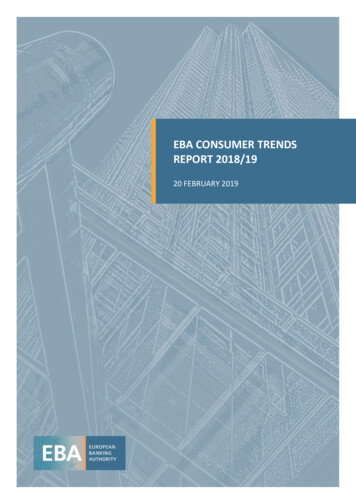
Transcription
Tackling Telework: What the NewNormal Looks Like for State andLocal GovernmentsMARKET TRENDS REPORT
Executive SummaryGovernors’ stay-at-home orders in response to thecoronavirus pandemic led many state and localgovernment agencies to shift almost overnight fromprimarily in-person operations to remote work. Thatmeant IT managers had to ensure employees had thetechnology and access to data and applications theyneeded to collaborate and do their jobs virtually.This was especially important for critical managementoperations such as finance and human resources (HR) –activities that are traditionally heavily onsite. Now, withseveral months’ hindsight, officials are able to assesshow well prepared they were to support those essentialoperations – and what they need to do to fill in gaps theexperience exposed.GovLoop surveyed 91 public sector employees, primarilyat the state and local levels, about their pandemicpreparedness. In this report, we look at how state andlocal agencies can get and stay resilient in this newnormal. We also provide insights from Ray Elwell, MarketAdvisory Program Manager at Workday, a provider ofenterprise cloud applications for finance and HR.2MARKET TRENDS REPORT
BY T H E N U M BE RS27%of survey respondents said they were still workingfrom their job sites full-time.Source: GovLoop Survey46%of respondents said theywere fully remote.53%of respondents said their continuity ofoperations plans (COOPs) changed drasticallyor somewhat since the pandemic started.Source: GovLoop SurveySource: GovLoop Survey50%Telework is more common at stateagencies (64%) than local ones (19%).of respondents said management functions such asenterprise planning and finance continued withoutinterruption when offices closed.Source: State and Local Government Workforce:2020 SurveySource: GovLoop Survey24%of respondents said theiragencies experiencedchallenges and that fixingthem is a top priority.Source: GovLoop Survey68%of respondents said they received the same levelof support and services when they switched toremote work.64%of local government chiefinformation officers saidthe IT department receivedstrong support during thepandemic.Source: The Computing Technology Industry Association’s“IT Operations and Support: COVID-19 and the LocalGovernment IT Response” report60%of local government CIOssaid at least half their ITstaff is teleworking.Source: CompTIA’s “IT Operations and Support: COVID-19and the Local Government IT Response” reportSource: GovLoop SurveyTACKLINGTACKLING TELEWORK:TELEWORK: WHATWHAT THETHE NEWNEW NORMALNORMAL LOOKSLOOKS LIKELIKE FORFOR STATESTATE ANDAND LOCALLOCAL GOVERNMENTSGOVERNMENTS3
T H E C H A L L E N GEReacting vs. PreparingEndorsements of and efforts toward enabling teleworkaren’t new: Government agencies at all levels have increasedtheir support for telework over the last 10 years. Still,some government operations, including financial and HR,have traditionally been designed for onsite work, requiringwet signatures on paper documents, for instance. Thecoronavirus pandemic has highlighted the shortcomings ofthat approach.When agencies temporarily shuttered in response to thecoronavirus, their business offices still had to ensure workers,contractors and vendors were paid, and that hiring processescontinued even though that meant showing up to offices toreview and forward papers. The GovLoop survey found thatless than half of respondents have been fully remote sincethe pandemic struck.A main reason for that was concern about what teleworkwould mean for employees’ access to financial and HRsystems. Will they have internet access? Will they be able toaccess agency systems remotely? Will they use personal oragency-issued devices? And how will they get the right peopleto sign off on all those paper documents?“Governments can’t just shut down and wait it out,” Elwellsaid. “If you look at what’s going on nationally with theeconomic conditions, we can’t just say, ‘Our payroll processhas to be on-premise and we need six people to run it, soyou’ll get paid eight or 10 weeks from now, when we’re ableto get back to work.’ It’s just not possible.”The key issue is preparation verses reaction. Twenty-fivepercent of respondents said they were unprepared orwoefully unprepared for remote work this time around.As a result, IT managers reacted, unable to rely on disasterrecovery and continuity of operations plans to guide them.Many of those plans are based on the idea of having tomove from an office to an emergency operations center, notemployees’ homes.T H E S O LU T I O NUntether Workers From the Office With Cloud SolutionsIt’s clear that agencies need to adapt – and not only for thecurrent pandemic but to be ready for whatever comes next.To do that, agencies need to replace legacy technologies withmodern, cloud-based solutions that enable them to extendoperations to wherever employees are.“Traditionally, I think governments have looked at COOP asjust a document that says, ‘If this event happens, here are the12 things we need to do to be able to respond effectively,’”Elwell said. “But it’s actually more than that. It’s a biggerprocess. Reacting and planning really aren’t the same thing.”Cloud can support remote workers today and in thefuture because it offers the flexibility and scalability thatgovernment agencies need to shift operations quickly. What’smore, it facilitates access and communication, eliminatingthe need for those ink signatures and digitizing paper-basedprocesses so employees, for example, can switch from paperto digital time cards that supervisors can sign electronicallyand automatically pass to the payroll team to process.Reacting is what IT managers did in March. Now, they aretaking a step back to reassess the planning element withthe benefit of recent lessons learned. The result will beCOOPs that incorporate short- and long-term remotework capabilities based on cloud infrastructure that enablemore agency functions – finance and HR, among them –to seamlessly move online for any disruption to normaloperations, be it from a natural disaster or a second wave ofCOVID-19.This also lays a foundation to revamp COOPs.4MARKET TRENDS REPORT
B E S T P R AC TI C E S4 Ways Cloud Supports Remote WorkThe non-medical response to the coronavirus has put the spotlight on IT, particularly government agencies’ need toprovide essential services without disruption. To make those changes, Elwell offered four best practices:1.Five years ago, talk of cloud in financial and HR offices was virtually unheard of,but today, those conversations are more common. “Now that cloud technologyhas become more accepted in the government industry, we see organizationsthat are only going to the cloud. They’re not looking to on-premises solutions,” hesaid. Agencies that were most successful with remote work during the pandemichad cloud, rather than on-premise, applications.2.Agencies also need to invest in cloud services such as software-as-a-serviceand platform-as-a-service solutions, which enable employees to focus onmission-critical technology, rather than maintaining outdated systems.3.What’s more, outsourcing disaster recovery and COOP operations to cloudproviders is less costly than handling them yourself, not to mention that manyagencies say they can’t match the system access that cloud vendors can provide,Elwell said.4.Lastly, they need to implement mobile technologies that allow employees tohandle tasks with a tap of their fingers. “Having that access so that I can requesttime off on my phone or see my schedule on my phone those are the kindsof things where technology can really stabilize and make an organization moreeffective,” Elwell said.All of these go a long way toward improving HR and financial functions’resiliency. “We look at resilience as a standard operating procedure,” Elwellsaid. “One of the things we see organizations doing is relying on systems todo things that were manual.”TACKLING TELEWORK: WHAT THE NEW NORMAL LOOKS LIKE FOR STATE AND LOCAL GOVERNMENTS5
C A S E S T U DYLas Vegas Valley Water DistrictThe Las Vegas Valley Water District, Southern Nevada WaterAuthority and Springs Preserve were in better shape thanmany government agencies when work shifted online. That’sbecause the three organizations that deliver safe water tomore than 1 million people had been using Workday’s cloudbased Human Capital Management suite for three years.As a result, a majority of employees, especially those whowork in the field, were accustomed to entering their hoursvia a smartphone; they don’t even have computers, said LouReinbold, HR Manager at the Las Vegas Valley Water District,Southern Nevada Water Authority and Springs Reserve. Thesame goes for supervisors who approve those submissionsand those who handle payroll and benefits.“We’re able to have one centralized application that does alot of these core HR functions and financial functions in oneplace, and so employees are used to using it,” Reinbold said.“They know that if all their pay information is still available tothem, they can get to it from their phone, they can make allthose changes.”“The biggest reason that we wereable to pretty seamlessly goremote within a day and a half ortwo days was just the technologythat we have in the background,”- Lou Reinbold, HR Manager at the Las Vegas ValleyWater District, Southern Nevada Water Authority andSprings ReserveThe result is that more people than he expected have beenable to work remotely, seamlessly and securely. “The biggestreason that we were able to pretty seamlessly go remotewithin a day and a half or two days was just the technologythat we have in the background,” he said.Learn more: www.workday.comWhat’s more, the organizations had already begun movingaway from paper processes by implementing digitalsignatures and automated routing, further enabling criticaloperations to continue uninterrupted when things changed.Still, the shift strained the infrastructure, Reinbold said. “Ifwe truly had to have every employee log in to our network,we wouldn’t have had the capacity if we had to use VPNconnections,” he said.Workday’s solution allayed his security concerns, too. That’sbecause it sits outside the on-premise network, and accessrequires two-factor authentication. “That lessens the needfor offsite employees to connect to a computer onsitebecause it is cloud-based,” Reinbold said.6MARKET TRENDS REPORT
ConclusionGovernment’s ability to provide services seamlessly has never been moreimportant, and public servants stepped up to ensure that critical managementoperations remained in place.Government leaders must look at how COOP and disaster recovery plans accountfor long-term displacements – something legacy technology simply can’t support.Cloud services offer the flexibility and scalability that government agenciesneed to shift operations quickly. Plus, cloud facilitates workers’ ability to accessapplications and networks from wherever they are. For the HR and financialdepartments, replacing paper-based processes with digital documents ande-signatures sets the stage for modern operations not just in dire times, but allthe time.A B O U T WO RK DAYABOUT GOVLOOPWorkday is a leading provider of enterprise cloudapplications for finance, HR, and planning. Founded in 2005,Workday delivers financial management, human capitalmanagement, and analytics applications designed for theworld’s largest companies, educational institutions, andgovernment agencies.GovLoop’s mission is to “connect government to improvegovernment.” We aim to inspire public-sector professionalsby serving as the knowledge network for government.GovLoop connects more than 300,000 members, fosteringcross-government collaboration, solving commonproblems and advancing government careers. GovLoopis headquartered in Washington, D.C., with a team ofdedicated professionals who share a commitment toconnect and improve government.Learn more: t.htmlFor more information about this report, please reach out toinfo@govloop.com.TACKLING TELEWORK: WHAT THE NEW NORMAL LOOKS LIKE FOR STATE AND LOCAL GOVERNMENTS7
1152 15th St. NW Suite 800Washington, DC 20005P: (202) 407-7421 F: (202) 407-7501www.govloop.com@GovLoop
4 MARKET TRENDS REPORT Endorsements of and efforts toward enabling telework aren't new: Government agencies at all levels have increased their support for telework over the last 10 years. Still, some government operations, including financial and HR, have traditionally been designed for onsite work, requiring










